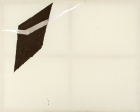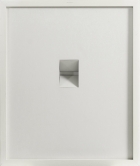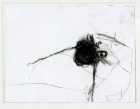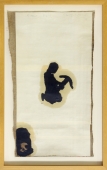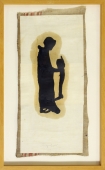
Artist | Axel Kasseböhmer (1952 - 2017)
https://www.artist-info.com/artist/Axel-Kasseboehmer
Biography
Biography
Axel Kasseböhmer was born in Herne in 1952 and studied at the State Academy of Art in Düsseldorf, where he still lives.
About the work (english)
About the work (english)
Axel Kasseböhmer is one of the group of artists who, in line with attempts to find a new form of figurative art, as of 1980 turned their attention to painting and started exploring in a controlled manner the conditions of painting. Although Kasseböhmer only studied under Gerhard Richter for a few months, he has much in common with the latter's reflective attitude to painting.
In an age in which the academies teach modernism, Kasseböhmer believes any radical break with Tradition is a thing of the past. Currently, the whole range of different styles is available to artists and ideological barriers have fallen. Yet Kasseböhmer does not believe painting inexorably progresses as it develops. In a manner that resembles a child writing he carefully spells out the visual language of painting, if from a reflective vantage point. He repeats the basic forms of painting in order to make sure of them and presents them as a universally valid vocabulary.
His paintings on paper quite simply appear provocative. For example, one of his landscapes consists solely of broad brush strokes in one and the same bright green. The theme of the picture does not originate in a view of nature; indeed, there is no equivalent of the trees in the outside world that surrounds us and they are also not part of an emotional landscape in some inner reality. Like all of Kasseböhmer's pictures, the theme here is taken from painting itself, from the history of painting and the qualities painting has as a media. By radically simplifying and isolating the means he uses - the colour, the motif, the brush strokes - he turns our attention via the picture to painting itself.
Kasseböhmer shows that a picture is always abstract even if it depicts a particular object. For him, layers of paint are elements of the picture. The one layer may cover over others, serve as their background, flow into them or gradually replace them; it may suddenly cease at a given point or be scratched or scraped away after having been applied. From a certain point onwards Kasseböhmer lets the paint take its own course and no longer intervenes in its "behaviour" on the surface. For example, with his "Landscape in Green, Black, White" different surface structures in the two halves of the picture generate the impression of features such as hardness, smoothness, transparency and dissolution on the one hand, (reminding you, perhaps of water) and, on the other, of resistance, of structure, of contrast and of space. At three junctures the two domains meet; the extremely thin paint runs or "grows" upwards into the lattice structure.
Object-like and abstractforms emerge in Kasseböhmer's pictures. Yet he would appear to wish to elide precisely this distinction. The abstract always contains the potential to become an object. And, conversely, the white curvy line can become the surface of the water, can allude to an animal or, as the contour of two trees, become an abbreviation for a landscape. An object such as a vase, when serialized, becomes a pattern, a carpet-like motif or an ornament. And by means of these "haphazardly" drawn outlines that trace the form of vases he introduced the element of hand writing into the picture.
Kasseböhmer's works on paper point up an interconnection of writing, ornamentation and pictogrammes: here, the blue lines of the brush are at one and the same time abbreviations for writing, ornaments and a sign for water. Together with the brown formations, the picture reminds you of a bay where land and sea meet. Kasseböhmer believes paintfunctions as a sign: green, for examplc, signiftes vegetation, blue the sky or water. And the forms become graphic symbols.
The transition to the abstract or to the objective occurs in the course of countless interim stages. Much seems to be left unfinished in the paintings, as if they stopped suddenly in the midst of emerging: landscape, tree, vase, bird, andfish. They become a pattern or an ornament. It is as if Kasseböhmer were asking after each completed picture: How could I paint the same thing but in an utterly differently way?
Occasionally he does not paint on canvas or wood but on black-and-white photographs, which serve, as it were, as the hand-drawn outlines that he works up. Kasseböhmer the painter would seem to wish to anchor his art in external reality with his choice of photography, of that hybrid of pictures and the documentation of pure facticity.
In the early Eighties his work was shaped by its affinity to paintings by the old masters: he took as the models for his pictures sections from famous paintings by Jan van Eyck, Fra Angelico and Nicolas Poussin, for example. His artistic approach is characterized by this linking to the achievements of past masters: "In actual fact everything is a quotation. If I paint a flower vase, then it's a quotation. Each picture is closer to all other pictures than it is to an object." The traditional themes of painting, such as landscapes and still lives are thus imbued with renewed interest. Yet these paintings are not based on nature but are created parallel to nature, generated solely in a creative process that remains within the domain of art. Axel Kasseböhmer was born in Heme in 1952 and studied at the State Academy of Art in Düsseldorf, where he still lives.
About the work (deutsch)
About the work (deutsch)
Axel Kasseböhmer gehört zu jenen Künstlern, die sich um 1980 im Zuge des Aufbruchs zu einer neuen figurativen Kunst der Malerei zuwandten und auf kontrollierte Weise deren Bedingungen zu erforschen suchten. Er hat nur einige Monate bei Gerhard Richter studiert, und doch verbindet ihn viel mit dessen reflexiver Haltung zur Malerei.
In einer Zeit, in der die Moderne den Lehrstoff der Akademien abgibt, hält Kasseböhmer den radikalen Bruch mit der Tradition für obsolet. Alles ist wieder offen. Die Stile sind in ihrer Vielfalt verfügbar, ideologische Schranken verschwunden. Der Künstler glaubt nicht an einen kontinuierlichen Fortschritt in der Entwicklung der Malerei.
Kasseböhmer buchstabiert, ähnlich wie ein Kind die Schriftsprache, die Bildsprache der Malerei, wenn auch von einem reflektierten Standpunkt aus: Er wiederholt Grundformen der Malerei, um sich ihrer zu vergewissern, führt sie als allgemein gültiges Vokabular vor Augen.
Seine Malereien auf Papier muten zum Teil provozierend einfach an. Eine der Landschaftszeichnungen zum Beispiel besteht nur aus den breiten Pinselstrichen eines einzigen leuchtend-grünen Farbtons. Das Thema des Bildes ist nicht aus der Naturanschauung gewonnen; die Bäume haben kein Äquivalent in der äußeren Welt, die uns umgibt, sind auch nicht Teil einer Seelenlandschaft, einer inneren Realität. Das Thema dieses, wie aller Bilder Kasseböhmers, entstammt der Malerei selbst, ihrer Geschichte ebenso wie ihrer mediälen Eigenschaften. Durch radikale Vereinfachung und Vereinzelung seiner Mittel - Farbe, Motiv, Pinselstrich - werden wir durch das Bild auf die Malerei selbst verwiesen.
Kasseböhmer zeigt, daß das Bild immer auch abstrakt ist, selbst wenn es Gegenständliches darstellt. Farbschichten sind die Elemente des Bildes. Die eine Schicht kann die andere überdecken oder ihr als Hintergrund dienen, in sie hineinfließen oder sie verdrängen, an einer Stelle ausgespart bleiben oder nachträglich aufgekratzt oder abgeschabt sein. Von einem bestimmten Zeitpunkt an entläßt der Maler die Farbe aus seiner Kontrolle und greift in ihr "Verhalten" auf der Fläche nicht mehr ein. Bei der „Landschaft grün schwarz weiß" etwa erzeugen unterschiedliche Oberflächenstrukturen der Bildhälften den Eindruck sinnlicher Qualitäten wie Härte, Glätte, Transparenz, Auflösung einerseits - man denkt zum Beispiel an Wasser - und Widerstand, Struktur, Kontrast, Raum andererseits. An drei Stellen verbinden sich die beiden Bereiche miteinander; die extrem dünnflüssige Farbe fließt oder "wächst" in die Gitterstruktur nach oben hinein.
Auf den Bildern Kasseböhmers entstehen gegenständliche und abstrakte Formen. Doch der Künstler scheint diesen vermeintlichen Unterschied gerade aufheben zu wollen. Das Abstrakte enthält immer auch ein gegenständliches Potential. Und umgekehrt: Die weiße Schlängellinie kann zur Wasseroberfläche, zur Andeutung eines Tieres werden oder als Kontur zweier Bäume zu einer Abbreviatur von Landschaft. Ein Gegenstand wie eine Vase wird in der Reihung zum Muster, zum Rapport, zum Ornament. Durch die "fahrig" gezogenen Umrisse der Vasenformen findet das handschriftliche Moment Eingang in das Bild.
Der Zusammenhang von Schrift, Ornament und Piktogramm wird bei einer der Arbeiten auf Papier deutlich: Die blauen Pinselzüge sind ebenso Schriftkürzel, Ornament und Zeichen für Wasser. Zusammen mit den braunen Formationen läßt das Bild auch an eine Meeresbucht denken. Bei Kasseböhmer besitzt die Farbe Zeichencharakter: Grün zum Beispiel bedeutet Vegetation, Blau Himmel oder Wasser. Und die Formen werden zu grafischen Symbolen.
Der Übergang zur Abstraktion beziehungsweise zur Gegenständlichkeit vollzieht sich in endlos vielen Zwischenschritten. Vieles wirkt unfertig, angehalten mitten im Entstehungsprozeß. Der Künstler greift immer wieder die gleichen Motive auf: Landschaft, Baum, Vase, Vogel und Fisch. Sie werden zum Raster, zum Ornament. Es scheint, als frage sich Kasseböhmer nach jedem vollendeten Bild: Wie kann ich es noch ganz anders malen? Gelegentlich malt er nicht auf Leinwand - oder Holz, sondern benutzt Schwarzweißfotografien, die ihm gleichsam als Vorzeichnungen dienen, die er weiter bearbeitet. Mit der Fotografie, diesem Zwitter zwischen Bild und der Bekundung reiner Faktizität, scheint der Maler seine Kunst doch noch in der äußeren Wirklichkeit verankern zu wollen.
In den frühen Achtziger Jahren bestimmte die Affinität zu den Gemälden alter Meister seine künstlerische Arbeit: Er hat Ausschnitte berühmter Werke etwa von Jan van Eyck, Fra Angelico und Nicolas Poussin als Vorlagen für seine Bilder benutzt. Die Anbindung der eigenen Arbeit an die Leistungen früherer Maler charakterisiert seine künstlerische Haltung: "Eigentlich ist alles zitiert. Wenn ich eine Blumenvase male, ist die auch Zitat. Jedes Bild ist jedem Bild näher als jedes Bild irgendeinem Gegenstand." Die traditionellen Bildthemen Landschaft und Stilleben werden so wieder interessant. Die Arbeiten sind jetzt aber nicht nach der Natur, sondern parallel zur Natur geschaffen, gewonnen allein aus einem kunstimmanenten Schöpfungsprozeß.
German text by Stefanie Hauer / Translation by Jeremy Gaines
(Extract - Full printed version available in the Museum)
MMK - Museum für Moderne Kunst, Frankfurt am Main
 offers / Requests offers / Requests  |
About this service |
|---|
 Exhibition Announcements Exhibition Announcements  |
About this service |
|---|
 Visualization |
Learn more about this service | ||
|---|---|---|---|

Interested in discovering more of this artist's networks?
3 easy steps: Register, buy a package for a visualization, select the artist.
See examples how visualization looks like for an artist, a curator, or an exhibition place: Gallery, museum, non-profit place, or collector.

Exhibition History

|
SUMMARY based on artist-info records. More details and Visualizing Art Networks on demand. Venue types: Gallery / Museum / Non-Profit / Collector |
||||||||||||
| Exhibitions in artist-info | 25 (S 3/ G 22) |
Did show together with - Top 5 of 377 artists (no. of shows) - all shows - Top 100
|
||||||||||
| Exhibitions by type | 25: 11 / 9 / 4 / 1 | |||||||||||
| Venues by type | 17: 5 / 7 / 4 / 1 | |||||||||||
| Curators | 9 | |||||||||||
| artist-info records | Jan 1982 - Apr 2015 | |||||||||||
|
Countries - Top 3 of 3 Germany (16) United States (4) France (1) |
Cities - Top 5 of 12 Frankfurt am Main (6) Köln (6) München (3) Düsseldorf (2) Williamstown (1) |
Venues (no. of shows )
Top 5 of 17
|
||||||||||
Curators (no. of shows)
Top 5 of 9
|
| Deutsche Bank Collection - Artists | S | Apr 2015 - Apr 2015 | Frankfurt am Main | (1) | +0 | |
| Museum - MMK | G | Jun 2011 - Oct 2011 | Frankfurt am Main | (106) | +0 | |
| Sprüth Magers - Köln | S | Nov 1999 - Jan 2000 | Köln | (33) | +0 | |
| Galerie Philip Nelson | G | May 1998 - May 1998 | Paris | (11) | +0 | |
| Museum - MMK | G | Jan 1998 - May 1998 | Frankfurt am Main | (106) | +0 | |
| Ammann, Jean-Christophe (Curator) | +0 | |||||
| Sprüth Magers - Köln | G | Sep 1997 - Nov 1997 | Köln | (33) | +0 | |
| Keep reading |














